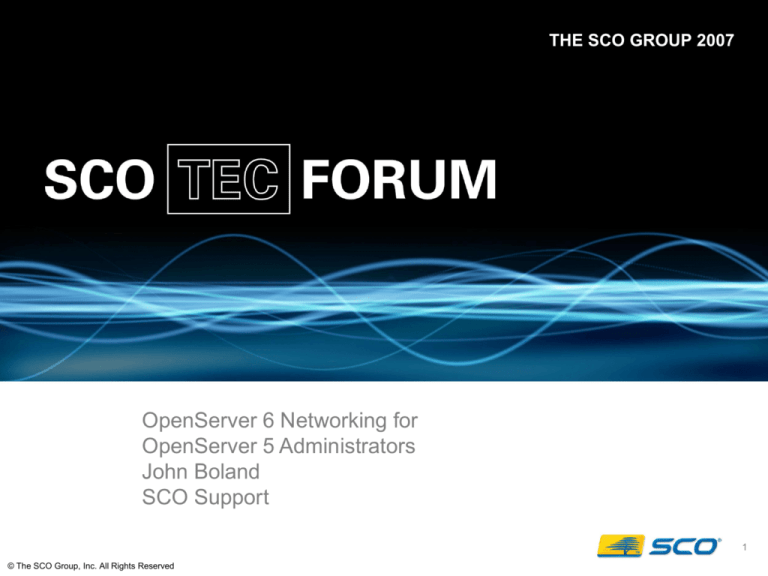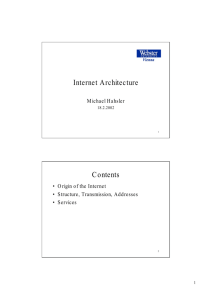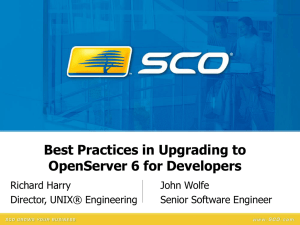
THE SCO GROUP 2007
OpenServer 6 Networking for
OpenServer 5 Administrators
John Boland
SCO Support
1
© The SCO Group, Inc. All Rights Reserved
Session Objectives
At the end of this session you should:
Understand the ISL differences between OpenServer
6 and OpenServer 5 relating to Networking
Be aware of how OpenServer 6 networking starts on
system boot
Know how to enable tcp wrappers on inetd services
Understand how netconfig(ADM) differs between
OpenServer 6 and OpenServer 5
Know how to configure and use ssh(1)
Be able to configure a simple VPN using IPsec
2
Session Topics
The following topics will be covered
OpenServer 6 Installation
Network Configuration Manager differences
OpenServer 6 Network Start-up
Configured Network Services on OpenServer 6
tcpd(ADM) aka Tcpwrappers
OpenServer 6 and OpenSSH
Using IPSec to implement a VPN
IP Filters Brief Overview
3
OpenServer 6 Installation
OpenServer 6.0.0 ISL Networking Differences:
Samba, PPP and Kerberos installed at ISL
IPX/SPX, SCO Gateway for Netware and Lan
Manager Client packages obsolete
DHCP client configuration at ISL
Only drivers for detected Network Cards (NICs) are
displayed at ISL
Manual list only contains non-autodectable ISA NIC cards
4
OpenServer 6 Installation
OpenServer 5 Connectivity Package Selection
5
OpenServer 6 Installation
OpenServer 6 Connectivity Package Selection
6
OpenServer 6 Installation
Network Card Selection on OpenServer 5
7
OpenServer 6 Installation
Network Card Selection on OpenServer 6
8
Network Configuration Manager
OpenServer 5 Network Configuration Manager:
9
Network Configuration Manager
Network Configuration Manager Differences:
No localhost entry
Removed the IPX protocol
NFS protocol configured by default (if installed)
Only Auto-detected Network Cards are displayed
No relink and reboot required when you add a card
Removed WAN configuration
Failover support added
10
Network Configuration Manager
Network Interface Card (NIC) Drivers and netconfig(ADM)
NIC drivers are stored under
/etc/inst/nd/mdi
Find out what nd driver package is installed using:
pkginfo –l nd
Get the latest nd driver package (8.0.6e) at:
http://www.sco.com/support/update/download/release.php?rid=281
netconfig(ADM) uses PCI Board IDs to recognise cards
resmgr | more
18 e1008g 8 6 4 18 4400 443f fcde0000 fcdfffff - - 4 0x8086100E 0x0002 0 2 0
34 net0 8 6 - - - - - - - - - 0x8086100E - - 2 –
grep 0x8086100E /etc/inst/nd/mdi/e1008g/*.bcfg
/etc/inst/nd/mdi/e1008g/e1008g_100E.bcfg:BOARD_IDS="0x8086100E"
11
Network Configuration Manager
Automatic Network Failover and Backup cards
Must have MP2 installed
TA 110336: Not all NICs support failover. Check with:
grep "FAILOVER=true" /etc/inst/nd/mdi/<your nic driver>/*.bcfg
Can manually failover using netconfig(ADM)
Automatic failback is not currently supported
TA 126686: Cannot manually failback to the primary
NIC using netconfig(ADM). Instead you use:
nd failback net0
Note that while some NICs failover on removal of
cable, not all NICs do
12
Network Configuration Manager
Debugging netconfig(ADM):
When you run netconfig(ADM) you are running:
/usr/lib/netcfg/bin/ncfgUI
netconfig(ADM) configuration files held under
/usr/lib/netcfg
To trace problems uncomment:
#cmdtrace on [ open /tmp/ncfgUI.log a+ ]
netconfig(ADM) also uses ndcfg(ADM) to do NIC
configuration. The ndcfg log file is found at:
/usr/lib/netcfg/tmp/ndcfg.log
TA 110131: Troubleshooting NIC Installation
13
OpenServer 6 Network Start-up
/etc/inittab Network Start-up Entries
• Initialize the socket subsystem in the kernel at sysinit
iks0::sysinit:/sbin/initsock -d > /dev/console 2>&1
• Configure STREAMS at sysinit
sl::sysinit:/etc/slink -c /etc/strcf > /dev/console 2>&1
• Initialise the loopback interface at sysinit
loop::sysinit:/usr/sbin/initialize -u lo0 > /dev/console 2>&1
• Load STREAMS modules
ap1::sysinit:/sbin/autopush -f /etc/ap/sco.ap
• Start syslogd(ADM) to log local & remote messages
bchk::sysinit:/sbin/bcheckrc </dev/console >/dev/console 2>&1
14
OpenServer 6 Network Start-up
/etc/inittab Network Start-up Entries [contd]
• The following entries will be described in greater
detail on the slides that follow:
lli::sysinit:/etc/nd start < /dev/null > /dev/null 2>&1
tcp::sysinit:/etc/tcp start < /dev/null > /dev/null 2>&1
……. ……. ………..
r2:2:wait:/etc/rc2 1> /dev/console 2>&1 </dev/console
15
OpenServer 6 Network Start-up
Network Adapter Driver Script nd(ADM)
/etc/nd is used to start and stop configured NICs
It starts the dlpid(ADM) daemon which links each MDI
(MAC Driver Interface) driver to the common DLPI
(Data Link Provider Interface)
The dlpi module is a bit like your OSI Data Link Layer
The MDI interface sits between the card and the DLPI
/etc/nd is started by entry in /etc/inittab
lli::sysinit:/etc/nd start < /dev/null > /dev/null 2>&1
nd(ADM) is updated by netconfig(ADM) when adding
or removing NICs
16
OpenServer 6 Network Start-up
nd(ADM) [contd.]
Never try to update or modify /etc/nd manually
nd(ADM) man page incorrectly refers to
/etc/rc2.d/S35dlpi and
/etc/rc0.d/K97dlpi being used to start and stop nd
Can debug issues with /etc/nd by uncommenting:
#cmdtrace on [ open /tmp/nd.log a+ ]
or
#cmdtrace on stderr
17
OpenServer 6 Network Start-up
TCP Start/Stop Script tcp(ADMN)
/etc/tcp starts and stops TCP
When starting in single-user mode (sysinit) it will:
Read /etc/default/tcp to get info incl. domain and gateway
Call inconfig(ADM) to load default TCP kernel parameters
Configure network interfaces with IP addresses using
/usr/sbin/initialize -U
Will start syslogd(ADM) if not already started
Set default route using the gateway entry from
/etc/default/tcp
Start the streams error logging daemon, strerr(ADM)
Start the Pseudo Random Number Generator Daemon
prngd(ADM)
18
OpenServer 6 Networking Start-up
Single User Mode start-up:
init
intisock
slink
Initialize lo0
autopush
nd start
tcp start
syslogd
dlpid
Domain and
gateway
Setup TCP
Kernel Params
initialize netx
route add
Setup NICs
strerr(ADM)
prngd(ADM)
19
OpenServer 6 Network Start-up
tcp(ADMN) [contd]
When starting in multi-user mode (rc2) it will also:
Start prngd(ADM) again
Start inetd(ADMN), the Internet Super Server daemon
Start pppd(ADMN) only if MST PPP is configured (off by
default)
Start snmpd(ADMN), the snmp agent
Start named(ADMN) if nameserver is config’d (off by default)
Start sshd(8), the ssh daemon and if necessary generate
host keys (/etc/ssh/ssh_host*)
Start any daemons listed in /etc/default/tcp (off by default)
Start ntpd, lpd(ADMN) and aasd(ADMN) if configured (not by
default)
20
OpenServer 6 Network Start-up
tcp(ADMN) [contd]
Issues the messages:
add net default: gateway 192.168.248.1
Starting TCP services: prngd inetd snmpd sshd
The tcp(ADMN) man page incorrectly refers to ifconfig
when it should refer to initialize
Existing sessions can continue to function after a
tcp stop
Existing sessions are stopped by a
tcp shutdown
Can debug the /etc/tcp shell script by adding
set –x
21
OpenServer 6 Network Start-up
Networking services started by rc2(ADM)
The /etc/rc2 script is invoked by init(M):
r2:2:wait:/etc/rc2 1> /dev/console 2>&1 </dev/console
/etc/rc2 messages are logged to
/usr/adm/rc2.log
Networking Services scripts called by rc2 include:
S85tcp
S86rpc
P86sendmail
S87nfs
S90nis
P90apache
S95docview
S99cups
S99nmbd
S99smbd
Can disable a service as follows:
mv /etc/rc2.d/S87nfs /etc/rc2.d/s87nfs
shutdown –y –g0 –i6
22
OpenServer 6 Network Start-up
Network services started by traditional rc2(ADM)
S85tcp
Symbolic link to /etc/tcp
S86rpc
Symbolic link to /etc/rpcinit
Starts rpcbind(ADMN), rwalld(NADM) and sprayd
P86sendmail (or MMDF equivalent)
Starts sendmail(ADMN)
S87nfs
Symbolic link to /etc/nfs
Starts exportfs(NADM), nfsd(NADM), biod(NADM), mountd(NADM),
statd(1Mnfs), lockd(NADM), bootparamd(NADM) and pcnfsd(NADM)
S90nis
Symbolic link to /etc/nis
Not configured or started by default
23
OpenServer 6 Network Startup
Network services started by traditional rc2(ADM)
P90apache
Starts the apache web server on port 80
S95docview
Starts the OpenServer 6 documentation server on port 8457
S99cups
Starts the CUPS Print server, cupsd(8)
Remote admin is disabled by default (See TA 126211)
S99nmbd
Starts the NetBIOS name service, nmbd(8)
S99smbd
Starts the File and Print Server daemon, smbd(8)
24
OpenServer 6 default Network Services
Services controlled by inetd(ADMN)
inetd is knows as a Super Server
inetd is started by /etc/rc2.d/S85tcp (/etc/tcp)
inetd configures the services listed in
/etc/inetd.conf
inetd reads /etc/services (and /etc/protocol) to get the
name, aliases, port and protocol to use for each
service
25
OpenServer 6 default Network Services
Services controlled by inetd(ADMN)
On a traditional install inetd configures services including:
ftp
telnet
shell
login
exec
pop3
imap
swat
stream tcp nowait root
/etc/ftpd
ftpd -a
stream tcp nowait NOLUID /etc/telnetd telnetd
stream tcp nowait NOLUID /etc/rshd
rshd
stream tcp nowait NOLUID /etc/rlogind rlogind
stream tcp nowait NOLUID /etc/rexecd rexecd
stream tcp nowait root
/etc/popper popper
stream tcp nowait root
/etc/imapd imapd
stream tcp nowait root
/usr/sbin/swat swat
Can disable a service by commenting it out
# telnet stream tcp
nowait NOLUID /etc/telnetd
telnetd
And then restarting inetd with a SIGHUP
kill -1 `cat /etc/inetd.pid`
26
OpenServer 6 Networking Start-up
Multi-User Mode start-up:
rc2
S85tcp
S86rpc
S87nfs
P86sendmail
prngd
inetd
P90apache
S90nis
snmpd
S99cups
S95docview
sshd
aasd
S99smbd
S99nmbd
named
lpd
pppd
ntpd
27
OpenServer 6 Networking Start-up
Multi-User Mode start-up [contd]:
inetd
ftpd
telnetd
rlogind
imap
rshd
rexec
pop3
swat
28
OpenServer 6 and TCPWrappers
tcpd(ADM) aka tcpwrappers 7.6
Can be used to log and control access to inetd services
To enable tcpwrappers on telnetd:
Edit /etc/inted.conf
Comment out the entry:
telnet stream tcp
nowait NOLUID /etc/telnetd
telnetd
Uncomment the entry:
# telnet stream tcp
nowait NOLUID /etc/tcpd
telnetd
Save the file
Restart inetd using:
kill -1 `cat /etc/inetd.pid`
Telnet to the server and check syslog:
Jul 11 17:26:14 jrbt5 telnetd[2102]: connect from jrbhp1
29
OpenServer 6 and TCPWrappers
Controlling Access using tcpd(ADM)
hosts_access(SFF) control implemented using:
/etc/hosts.allow and
/etc/hosts.deny
These files contain no rules by default
Access is controlled as follows:
Grant access if you match an entry in the /etc/hosts.allow file
Deny access if you match an entry in the /etc/hosts.deny file
Otherwise, grant access
30
OpenServer 6 and TCPWrappers
Controlling Access using tcpd(ADM) [contd]
Entries in hosts.allow and hosts.deny are of the form:
daemon_list : client_list
daemon_list is a list of one or more daemon process
names or wildcards
client_list is a list of one or more host names, host
addresses, patterns or wildcards that will be matched
against the client host name or address
There are two basic options:
Deny all and add entries to /etc/hosts.allow (Mostly Closed)
Allow all and add entries to /etc/hosts.deny (Mostly Open)
31
OpenServer 6 and TCPWrappers
Some hosts_access(SFF) examples:
To deny everything, in /etc/hosts.deny add:
ALL: ALL
To allow everything leave /etc/hosts.allow empty
To allow exceptions in /etc/hosts.allow add:
ftpd: .friendly.domain
telnetd: ALL@192.168.124.1
rlogind: 192.168.1.0/255.255.255.0
To report on blocked access
ALL :ALL : spawn (echo Attempt from %h %a to %d at `date` |
tee -a /var/log/tcp.deny.log |mail jboland@sco.com )
32
OpenServer 6 and OpenSSH
OpenServer 6 MP2 ships with:
OpenSSH_4.2p1
The package provides:
ssh(1) (aka slogin(1)) for secure, encrypted login and remote
command execution
scp(1) for secure, encrypted remote copy
sftp(1) for secure, encrypted file transfer
Can also be used for, among other things:
Local Port Forwarding
Dynamic Port Forwarding
X11 Forwarding
33
OpenServer 6 and OpenSSH
OpenServer 6 ssh(1) Authentication:
Host Based Authentication using
/etc/ssh/shosts.equiv and/or ~/.shosts
/etc/ssh/ssh_known_hosts and/or ~/.ssh/known_hosts
RSA/DSA Authentication using:
~/.ssh/authorized_keys
Keyboard Username and Password authentication
(default fallback)
Try avoid using SSH 1 as its less secure than SSH 2
Always use RSA and not DSA if possible
34
OpenServer 6 and OpenSSH
Windows to OpenServer 6.0.0 RSA Authentication:
Use a Key Generator on your Windows PC to generate your
public and private keys and save the keys to a directory on your
PC
On the OpenServer 6 system create the .ssh directory using:
mkdir $HOME/.ssh
chmod 700 $HOME/.ssh
Create $HOME/.ssh/authorized_keys and add paste your
public key into this file
On the Windows PC configure your ssh Terminal Emulator to use
your private key
35
OpenServer 6 and OpenSSH
OpenServer 6 to OpenServer 6 RSA Authentication:
On the “client” OpenServer 6 system generate keys using
ssh-keygen –t rsa
On the “server” OpenServer 6 system create the .ssh directory
using:
mkdir $HOME/.ssh
chmod 700 $HOME/.ssh
Create $HOME/.ssh/authorized_keys and add paste the
$HOME/.ssh/id_rsa.pub public key from the client OpenServer 6
system into this file
Login from the OpenServer 6 client system using:
ssh <server_name> or ssh <user>@<server name>
36
OpenServer 6 and OpenSSH
OpenServer 6 ssh(1) Host Based Authentication:
Host Based Authentication can use
/etc/ssh/shosts.equiv and/or ~/.shosts
/etc/ssh/ssh_known_hosts and/or ~/.ssh/known_hosts
Server Side Configuration:
Create $HOME/.shosts with
192.168.1.250 jboland
jrbosr6.it.sco.com jboland
jrbosr6 jboland
Edit /etc/ssh/sshd_config and change/add
HostbasedAuthentication yes
IgnoreUserKnownHosts yes
IgnoreRhosts yes
37
OpenServer 6 and OpenSSH
OpenServer 6 ssh(1) Host Based Authentication:
Server Side Configuration [contd]:
Restart sshd using:
tcp restart
Client Side Configuration:
Edit /etc/ssh/ssh_config and change/add
HostbasedAuthentication yes
EnableSSHKeysign yes
From the client login to the server using:
ssh <server_name>
To debug use
ssh –v <server_name>
38
OpenServer 6 and OpenSSH
Uses for ssh Dynamic Port Forwarding:
Dynamic Port forwarding allows forwarding of traffic
via a local SOCKS Proxy Server to a remote secure
server using ssh(1)
Local SOCKS
Proxy Server
The Internet
Secure ssh
Server
39
OpenServer 6 and OpenSSH
Setup Dynamic Port Forwarding on OpenServer 6:
Setup a SOCKS Proxy Server as root using:
ssh –D 1080 jboland@<fqdn of OSR6 ssh server>
To configure Mozilla to use the SOCKS proxy:
Run mozilla
Select Edit -> Preferences… -> Advanced -> Proxies
Click the “Manual Proxy Configuration”
In the SOCKS Host: field put
localhost
In the Port: field put
1080
Click on OK
40
OpenServer 6 and OpenSSH
Setting up Dynamic Port Forwarding on Windows:
Setup a SOCKS Proxy Server using PuTTY as follows:
Launch PuTTY
Enter the Host Name of the remote server
Select Connection -> SSH -> Tunnels
Enter 1080 in the source port field
Click on the Dynamic Radio Button
Click Add
Click Open
41
OpenServer 6 and OpenSSH
Setting up Dynamic Port Forwarding on Windows:
Configure Firefox to use the SOCKS Proxy as follows:
Launch Firefox
Select Tools -> Options -> Advanced -> Networking
Click on Settings
Check the Manual proxy configuration: radio button
Enter localhost in the SOCKS Host: field
Enter 1080 in the source port field
Click OK
Click OK
Firefox is now configured to use the SOCKS Proxy
42
OpenServer 6 and OpenSSH
Setting up Dynamic Port Forwarding on Windows:
Configure PuTTY to use the SOCKS Proxy as follows:
Launch PuTTY
Enter the Host Name of the remote server
Select Connection -> Proxy
Check SOCKS 5 as the proxy type
Enter 1080 for the port
Click OK
Click OK
PuTTY is now configured to use the SOCKS Proxy
43
OpenServer 6 and IPsec
What is IPsec:
IPsec allows you to:
Encrypt IP packets between hosts and subnets
Authenticate IP Packets between hosts and subnets
Defined in http://www.ietf.org/rfc/rfc2401.txt
Authentication can be performed using Expanded
IPsec headers, keys or certificates
IPsec requirements:
OpenSSL 0.9.7 or later
openssl version
A configured and functioning network connection
44
OpenServer 6 and IPsec
IPsec Terminology:
Two types of IPsec configuration:
Transport encrypts IP Data only
Tunnel encrypts IP Data and IP Headers
Two types of Authentication protocol:
Authentication Header (AH) does authentication only and is
not recommended
Encapsulating Security Payload (ESP) does authentication
and encryption
In an IPsec configuration file:
SAD is Security Association Database
SPD is the Security Policy Database
45
OpenServer 6 and IPsec
To enable IPsec in the kernel:
Edit
/etc/conf/pack.d/inet/space.c
changing
int ipsec_enable = 0;
to
int ipsec_enable = 1;
Relink the kernel using:
/etc/conf/bin/idbuild –M inet
Reboot the server using
shutdown –y –g0 –i6
46
OpenServer 6 and IPsec
Simple OSR6 to OSR6 IPsec configuration:
On “sysa” create /etc/inet/sysa.ipsec.conf with:
add <sysa ip> <sysb ip> esp 0x10001
-m transport
-E 3des-cbc "thescogp12341234thescogp" ;
add <sysb ip> <sysa ip> esp 0x10002
-m transport
-E 3des-cbc "thescogp43214321thescogp" ;
spdadd <sysb ip>[any] <sysa ip>[any] tcp -P in ipsec
esp/transport/<sysb ip>-<sysa ip>/use ;
spdadd <sysa ip>[any] <sysb ip>[any] tcp -P out ipsec
esp/transport/<sysa ip>-<sysb ip>/use ;
47
OpenServer 6 and IPsec
Simple OSR6 to OSR6 IPsec configuration:
On “sysb” create /etc/inet/sysb.ipsec.conf with:
add <sysa ip> <sysb ip> esp 0x10001
-m transport
-E 3des-cbc "thescogp12341234thescogp" ;
add <sysb ip> <sysa ip> esp 0x10002
-m transport
-E 3des-cbc "thescogp43214321thescogp" ;
spdadd <sysa ip>[any] <sysb ip>[any] tcp -P in ipsec
esp/transport/<sysa ip>-<sysb ip>/use ;
spdadd <sysb ip>[any] <sysa ip>[any] tcp -P out ipsec
esp/transport/<sysb ip>-<sysa ip>/use ;
48
OpenServer 6 and IPsec
Loading the IPsec configuration:
On sysa run setkey(ADM):
ipseckey –f /etc/inet/sysa.ipsec.conf
On sysb run setkey(ADM):
ipseckey –f /etc/inet/sysb.ipsec.conf
To see the ESP traffic
tcpdump host sysa and sysb
To see the ipsec network statistics run:
netstat -nsp ipsec
To remove/flush the SAD and SPD entries use:
ipseckey –F
Ipseckey -FP
49
OpenServer 6 and IPsec
Using racoon for automatic key management
Keys need to be changed to maintain security
Manual changing of keys is time consuming and
prone to error
racoon(ADM) is a daemon that manages keys (and
certificates) on behalf of IPsec
racoon(ADM) uses the Internet Key Exchange (IKE)
protocol to exchange keys securely between hosts
50
OpenServer 6 and IPsec
To configure racoon(ADM):
On sysa create the file /etc/inet/psk.txt with:
<sysb ip> <initial public shared key>
Make sure this file has perms 0400
chmod 0400 /etc/inet/psk.txt
On sysa create the file /etc/inet/sysa.ipsec.conf with:
spdadd <sysb ip>[any] <sysa ip>[any] tcp -P in ipsec
esp/tunnel/<sysb ip>-<sysa ip>/require ;
spdadd <sysa ip>[any] <sysb ip>[any] tcp -P out ipsec
esp/tunnel/<sysa ip>-<sysb ip>/require;
Perform similar steps on sysb
51
OpenServer 6 and IPsec
To configure racoon(ADM) [contd]:
On sysa create the file /etc/inet/racoon.conf with:
path pre_shared_key "/etc/inet/psk.txt" ;
log debug;
remote anonymous
{
exchange_mode aggressive ;
my_identifier address <sysa ip> ;
lifetime time 1 hour ;
proposal {
encryption_algorithm 3des;
hash_algorithm sha1;
authentication_method pre_shared_key ;
dh_group 2 ;
}
proposal_check obey;
}
52
OpenServer 6 and IPsec
To configure racoon(ADM) [contd]:
On sysa create the file /etc/inet/racoon.conf with:
[contd]
sainfo anonymous
{
pfs_group 2;
lifetime time 10 hour ;
encryption_algorithm 3des, blowfish;
authentication_algorithm hmac_sha1, hmac_md5 ;
compression_algorithm deflate ;
}
Create a similar file on sysb
53
OpenServer 6 and IPsec
To start racoon
Permissions need to be changed on /usr/sbin/racoon
chmod + x /usr/sbin/racoon
Start racoon on sysa and sysb using
/usr/sbin/racoon &
Configuration and Startup errors are logged in
/var/adm/syslog
On sysa run setkey(ADM):
ipseckey –f /etc/inet/sysa.ipsec.conf
On sysb run setkey(ADM):
ipseckey –f /etc/inet/sysb.ipsec.conf
54
OpenServer 6 and IPsec
To stop and restart racoon
To stop racoon run:
kill -9 `cat /etc/inet/racoon.pid`
rm /tmp/.racoon
Restart using
/usr/sbin/racoon &
55
OpenServer 6 and IPF
IP Filter Firewall Package for OpenServer 6.0.0
For a detailed HOW TO on firewall setup see:
http://osr600doc.sco.com/en/NET_tcp/ipf-howto.html
See also:
ipf(ADMN), ipfilter(M) and ipnat(ADMN)
Enable IP Filter as root using:
mkdev ipf
Display the current incoming and outgoing rules with:
ipfstat -io
56
Session Objectives
You should now:
Understand the ISL differences between OpenServer
6 and OpenServer 5 relating to Networking
Understand how netconfig(ADM) differs between
OpenServer 6 and OpenServer 5
Be aware of how OpenServer 6 networking starts on
system boot
Know how to enable tcp wrappers on inetd services
Know how to configure and use ssh(1)
Be able to configure a simple VPN using IPsec
57
Questions?
Any questions now?
For questions you think about later:
jboland@sco.com
58







